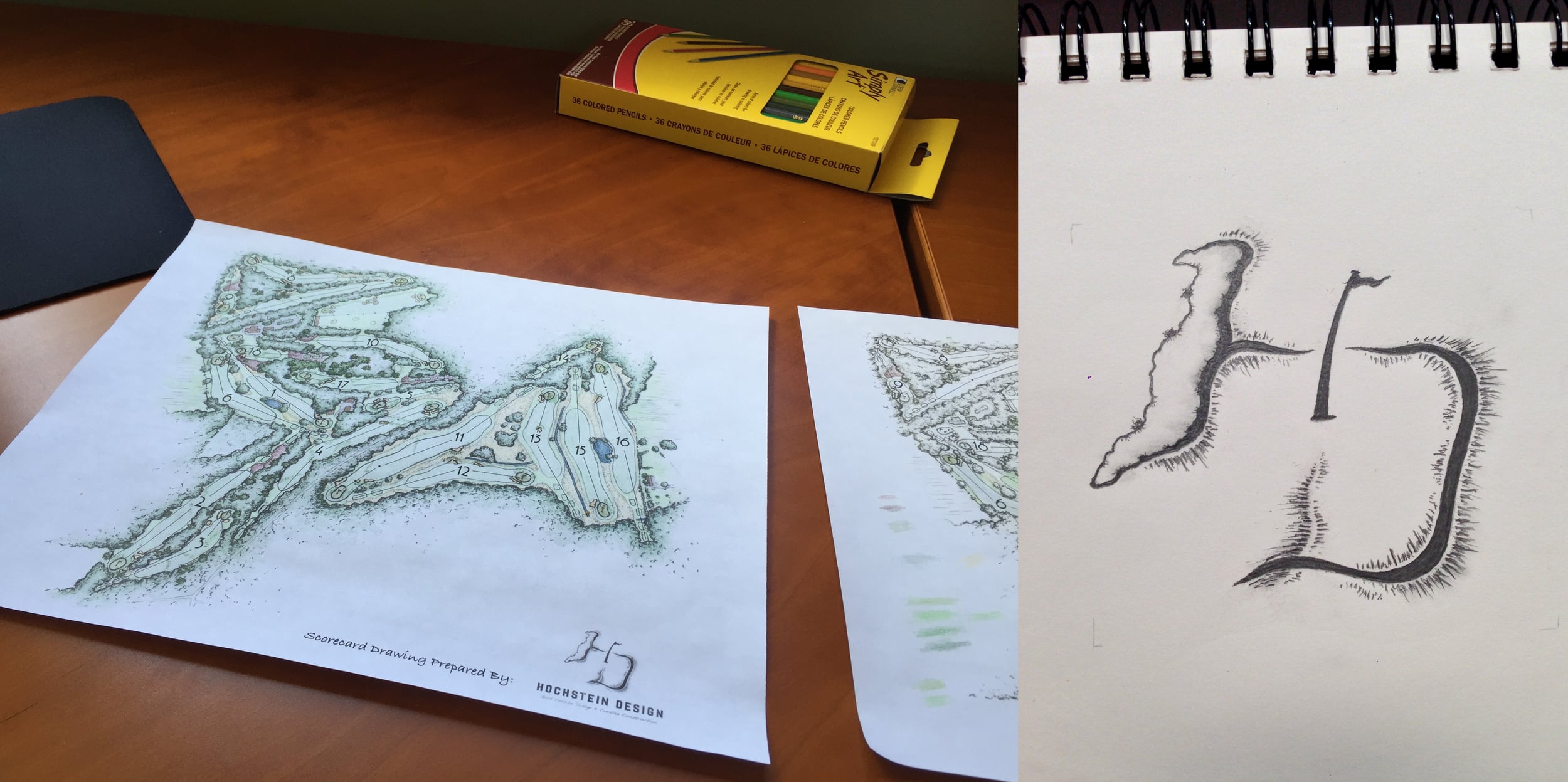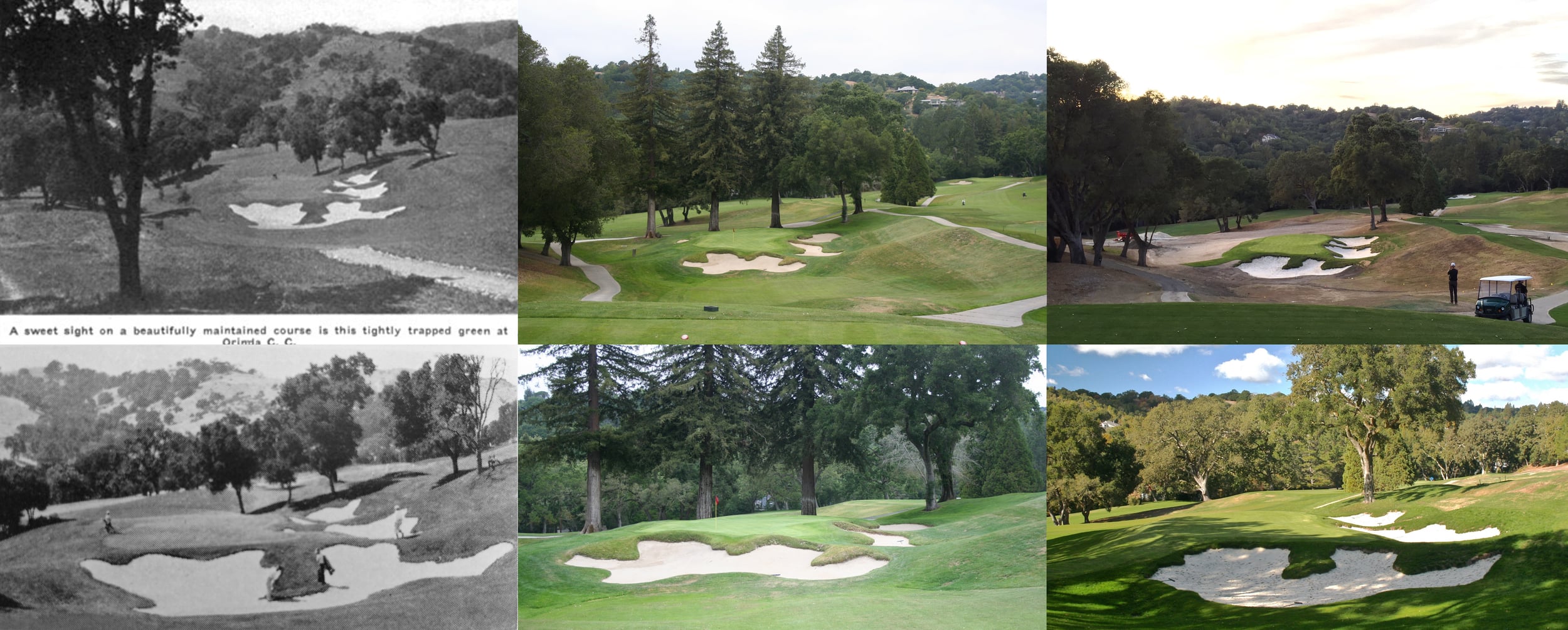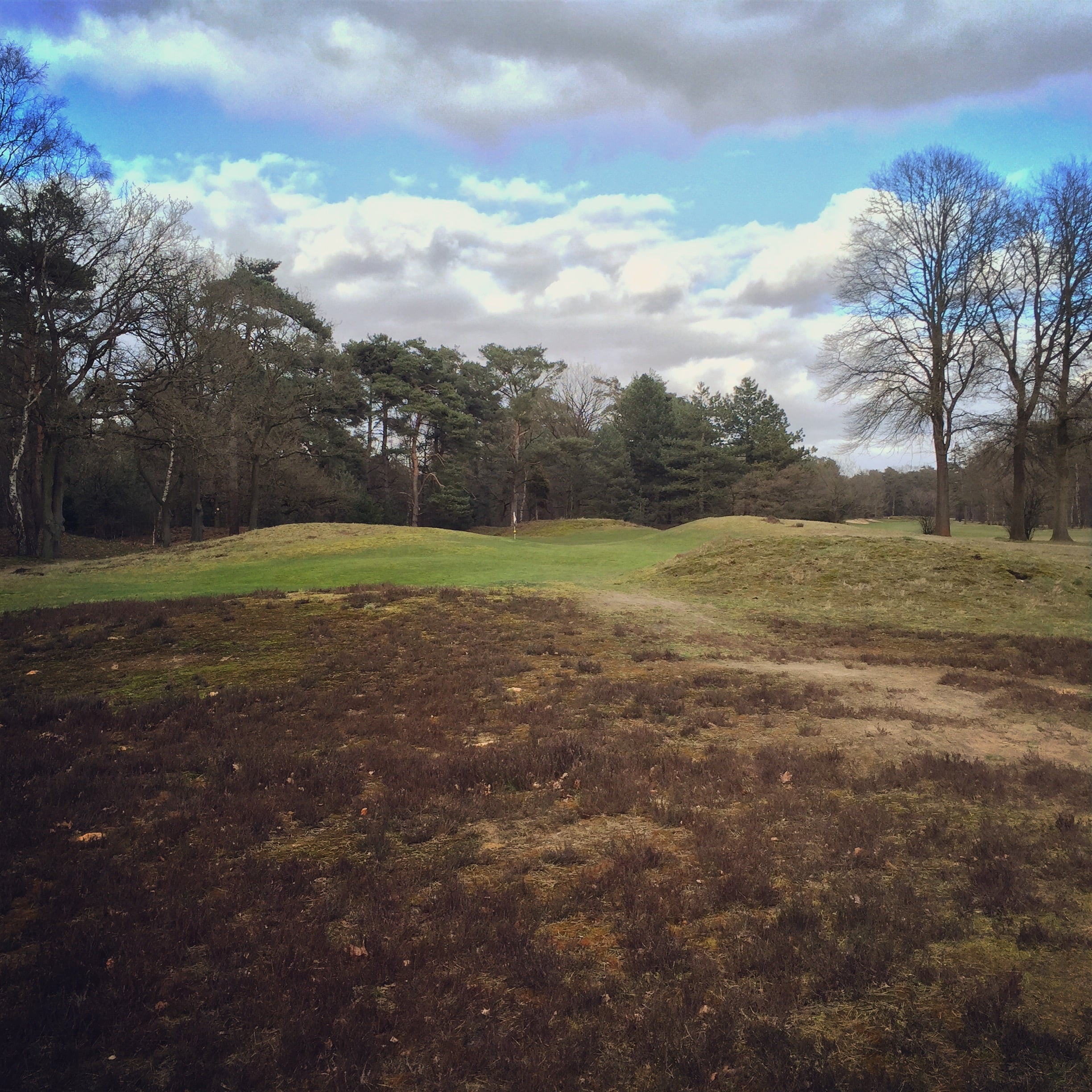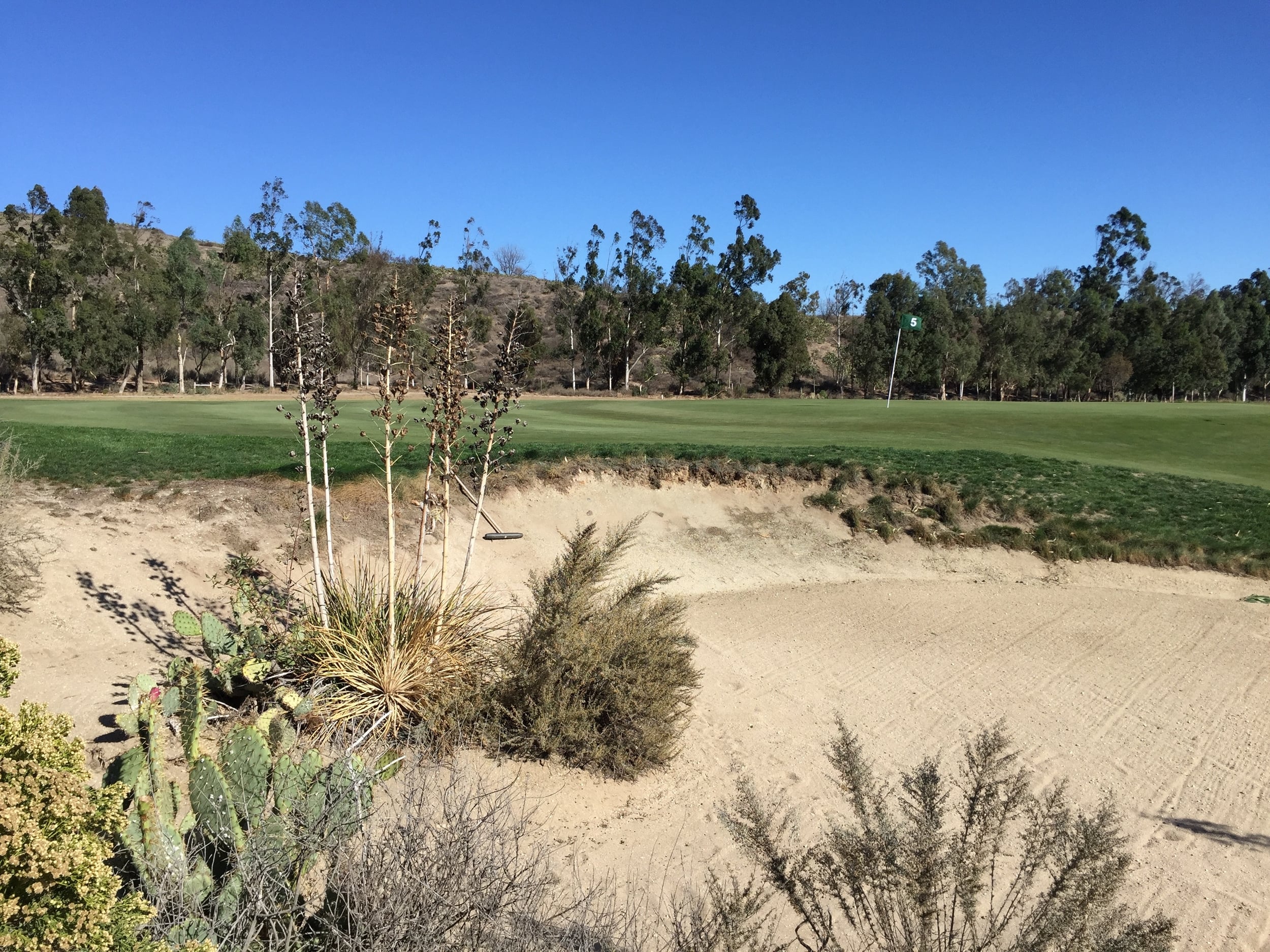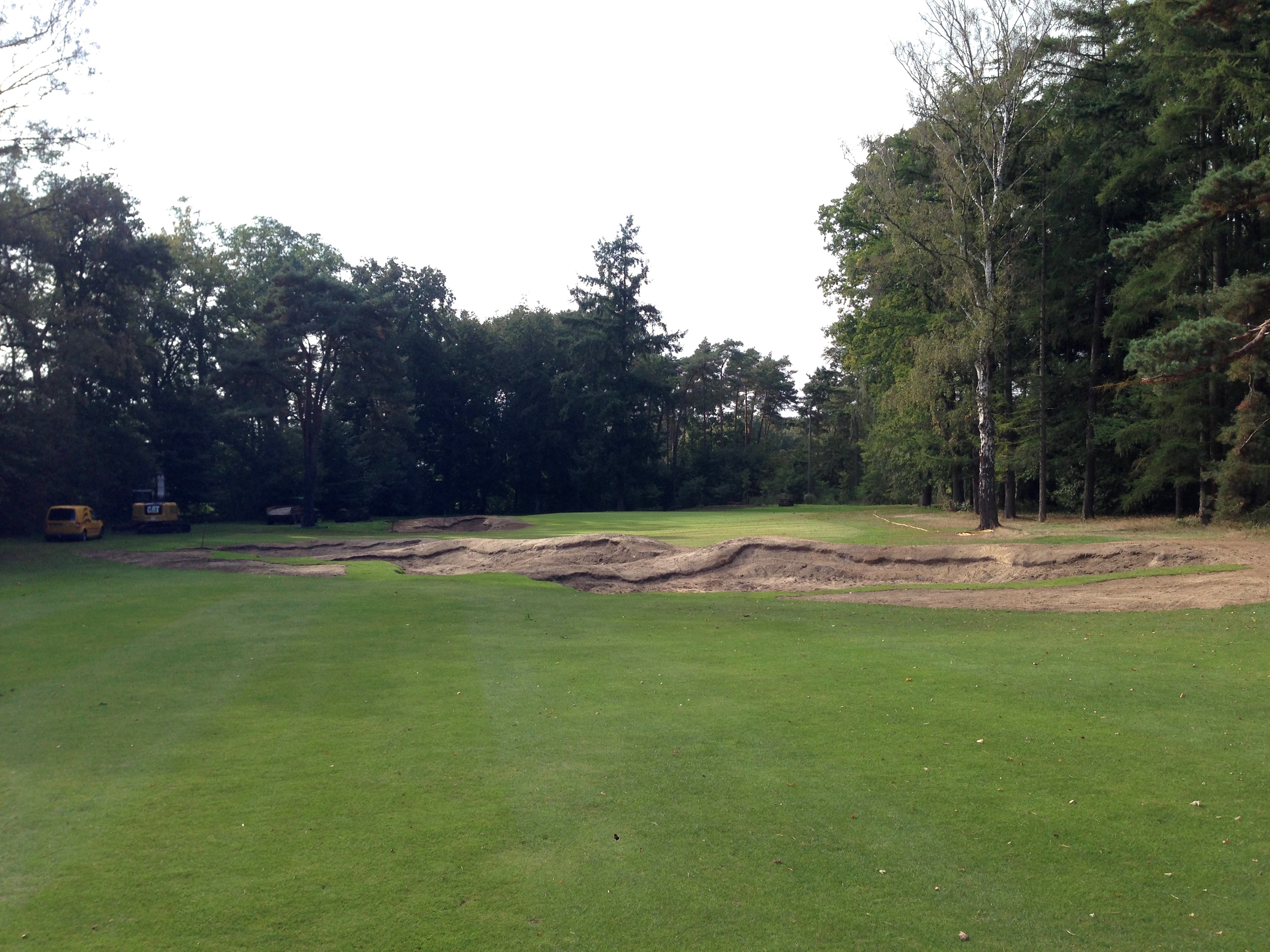Hole 18 at Orinda Country Club, only 15 minutes drive from my front door
It was another good year for myself and Hochstein Design, if a little less hectic and travelled compared to 2014. The year started at home with some administrative things, the most exciting of which was finally executing the "HD green complex" logo concept I had in my mind since first forming Hochstein Design a year prior. I continued to re-sharpen my drawing skills after being commissioned to create a scorecard plan drawing of the bunker changes Frank Pont and I had made at Sallandsche. Speaking of Sallandsche, fieldwork for the year kicked off with a trip back to Holland to hand edge the bunkers, which had been sodded and growing in over the winter. In seven quick work days, the 22 remaining bunkers were finalized, and 7 bunkers on the practice area were reworked with a mini-excavator and shovel. It was incredibly satisfying to see the finished results of the project, especially after having done all of the shaping, finish work, and edge cutting for each bunker. Due to time and soil types, there aren't that many opportunities to be that hands-on in a project, but we were lucky to have that at Sallandsche.
Sallandsche plan drawing and logo in progress
For the summer and biggest project of the year, I had the rare and pleasurable opportunity to work a home gig when Todd Eckenrode of Origins Golf Design (http://www.originsgolfdesign.com) asked if I would be interested in shaping on his upcoming project at Orinda Country Club, which was at the time the nearest course to where I lived. It is still just a 15 minute drive (in non-commuter Bay Area traffic) from my new location, and for four and a half months, I got to experience a taste of "regular" life (including being in that commuter traffic) where I worked long hours in the dirt but was able to come home every night to my own house and bed. Needless to say, it was nice. What was also nice was working alongside fellow shaper/architect George Waters (http://georgewatersgolf.com), a San Francisco resident and someone I had worked with briefly at Cal Club, and new superintendent Josh Smith, a Lafayette neighbor also formerly of Cal Club and famous for his excellent golf paintings (http://www.joshsmithart.com). With Todd, George, Josh, and myself, we had four unique creative minds to carry forth the plan for the restoration/renovation of the 1924 William Watson design. The course has now transformed from a strict test of aerial accuracy to one with many options and some of the more fun shots to be had in Bay Area golf.
The year concluded with a trip to Tom Simpson's Hardelot Les Pins in the far north of France. Patrice Boissonnas and Frank Pont recently completed a major restoration of the Golden Age course, which sits only a mile from sea, but there are still some areas where they would like to improve things further. They decided to bring in Hochstein Design to help implement these improvements, which consisted of a few greens expansions, greens surrounds work, approach expansions, and a number of bunker edits. The greens work has been completed, and the rest will follow in January 2016.
The following lists and anecdotes are Hochstein Design's best moments of the year both on and off the machine, including favorite features built, courses seen, tourist spots, and tunes (gotta have tunes!). Thanks as always for reading and taking interest in this crazy and wonderful field of golf design and construction. Cheers!
WORK
This is what it's really all about--building and working on golf courses to make them more fun and interesting for all who play them. These are some of the year's highlights from doing what I love.
Favorite features worked on
1. 18th green and approach, Orinda CC. We lowered the sharply pitched hillside green of the medium length par 5 a good 3 or 4 feet to make it sit naturally on a nice existing landform. Bunkers were added front left and 40 yards short right center to challenge layups and run on shots, which are now more encouraged with a more open right side and increased short grass. The overall grade is a big steep slope, and the bunkers were made to look like the were tumbling down the hillside. The green itself is more wild but more playable at the same time. While the old version was a steep pad at a constant 6%+ grade, the new one has three sections at different levels, which allow for a variety of hole locations and changing day to day strategy. Material cut from the old green was used to build up the massive left falloff to get balls to stay there as opposed to running all the way down to the cart path and back down the hole. In the end, the drama of the uphill shot remains, but there are now a lot more playing options and short game variety for wherever your ball may end up.
2. Hole 13 green and surrounds, Orinda CC. The former par 3 green had an attractive bunker arrangement off the hill and to the right, but with the length of the hole and the narrow sloped entry, there was no way to fly and hold the green unless you were a single digit handicapper with high ball flight. After caving in the left bunkers, a nice little sloped corridor for bouncing in a ball emerged. A tiny part of the front left bunker was retained and made into a small centering bunker, and the leading edge of the large right side bunker was built up to help keep some shots from rolling into it. A back right corner pin was added, and the backside runoff area was built up to make the creek more visible and in play for those who go long. On top of these improved playability changes, Todd's plan had the entire tee box area blown up with a divisive fence and trees removed, a cart path moved away, and a blinding slope lowered to make the green and bunkers visible. I personally can't wait to go out there and hit some shots down the left corridor and try to hold the green.
Before (top) and after (bottom) comparisons of the 13th at Orinda
3. Hole 14 green expansion and edit, Hardelot Les Pins. This medium length par 3 was a combination of fun and frustration, as it was a real challenge to fit in a pinnable transition slope with a meter-plus fall from the back shelf to the front edge. The bigger the challenge, though, the bigger the reward, and this green turned out to be pretty special and certainly the wildest I've been a part of, which despite a still young career building greens says a lot. We expanded and lowered the back right section to have a pin behind the right-hand bunker. We also expanded and slightly widened the narrow front section of the long (45 yard) green and eliminated half of the bunker to the right so that shots missing the front section now have short game options for trying to get up and down. The most difficult part was trying to shelf in a middle pin in the transition slope without making the green appear too 'tiered' or artificial. After a number of attempts with Frank Pont and Patrice Boissonnas looking on, we got something that everyone was happy with. Hardelot now has its own version of the 16th at Pasatiempo, though this one is more dynamic and offers an even greater variety of golf shots.
The front and back view of the freshly grassed 14th green at Hardelot Les Pins
4. Final bunker edging, Sallandsche. The ugliest phase of bunker construction is when sod is laid over the finished edge and left to take root. The edge detail is almost totally gone during that time. That is why it is so satisfying, if a little back-breaking, to take a spade and shovel and hack out that final edge and immediately see the final product you had been envisioning for weeks or months. I am very proud and happy with how the bunkers came out at Sallandsche and look forward to seeing them mature.
The edge cutting process is instantly satisfying, as shown here at the 8th hole at Sallandsche.
5. Hole 14 green edit and bunkers, Orinda CC This was a slight and subtle change, but it had a big impact and is the kind of opportunistic detail work Hochstein Design loves to maximize. The skinny angled green on the short par 4 is unique among the greens at Orinda, and it turns out this was an alteration suggested by A.W. Tillinghast, which is not surprising. The key change here was lowering the front left part of the green while flashing up the back of the left greenside bunker to create an effect where that front part of the green is hanging out over the bunker, a very "Golden Age" type of feature. In lowering the green edge, a hole location could also be scooted closer to the edge, hopefully allowing for a flag profiled against the sand.
Hole 14 at Orinda before this year's work, where there was a missed opportunity on the left for a neat interaction between green and bunker
The retouched left corner of the 14th green at Orinda, which is now profiled against the sand, is the kind of detail work Hochstein Design prides itself upon.
Best Transformations
1. Hole 13 Orinda CC Visibility from the tees, a playing corridor down the left, a more tenable central approach, a shifted cart path, and elimination of a fence and trees at the tee have this par 3 remarkably improved both from a playability standpoint and an aesthetic one.
2. Hole 18 Green and Approach, Orinda CC The previous green was high, over-tilted, disconnected from the land, and surrounded in rough. The new one is lower, pinnable, connected to the landform, and surrounded in the front, right, and back in short grass and helping contours. New bunkers add to the aesthetic of the unique amphitheater setting, and the short right one poses all sorts of questions for how one will play their second, third, or fourth shots.
The revamped 18th at Orinda: more contour, more playable, more fun
3. Hole 14 Green, Hardelot Les Pins The whole front tongue of the green was reworked to increase hole locations, a bunker was half filled-in to open up short game possibilities, and a new pin was created behind the right side bunker. The difference in the type of shot between the front hole location and the back right one is immense, but the challenge level for both is still high.
4. Hole 4 greenside bunkers, Orinda CC. I had been eyeing these bunkers since the winter, basically calling "shotgun" on getting to work on them. The previous set was the most out of place on the course and apparently rebuilt because of washing from the rocky hillside. That outcrop of a hillside, which gives the hole its name "Meteor," and the long narrow green were screaming for something that fits more in the context of Northern California golf, and I feel we were able to pull that off while also diverting away surface water to reduce washouts.
Hole 4 at Orinda, before and after new bunker scheme
5. Hole 2 green surrounds, Orinda CC. This is one of the more unique green locations on the golf course, but before removing the clutter of artificial mounding around it, one would hardly know it. The connection to the beautiful surrounding oaks is now stronger, the bunkers on 4 are now visible from the fairway, the green is expanded back and right toward a dramatic falloff, and the golfer, when standing near the back, enjoys a nice 270 degree view of a deep native-covered bowl, the 4th hole, the 11th hole, and the fairway of the 2nd itself, which aligns with the famed 15th green.
Best Restored holes
These holes could easily be on the "Best Transformations" list, but they stand out on their own while also being the best representative of restoration type work.
1. Hole 15, Orinda CC This mid-to-long par 3 was featured in Robert Hunter's famous Golden Age book The Links, showing "a fine natural diagonal hazard," a rugged natural creek with the green sitting hard against its edge. Somewhere along the line though, a bunker was added between the green and the creek, the latest iteration cutting into about a third of what we believed was the original green pad. With ample pictures and Hunter's endorsement of the hole's merits, it was a no brainer to try and restore this hole. George Waters gets credit for shaping the green here, while I jumped in later to naturalize the right side O.B. line (previously an ivy covered fence) and to work on some of the creekside landforms. The result is one we are happy with and continues to look more like the original as the native matures along the creek.
Before, original, and after of the 15th hole at Orinda
2. Hole 8, Orinda CC The challenge and bones of this short little drop shot par 3 had not been lost, but it was certainly in need of a restorative facelift. Going off of early photos from the 20s, we began with eliminating small bunkers at the left and back areas of the green and making those short grass runoffs (we also built those up a little to reduce the severity of them). Non-native redwoods at the back were eliminated to restore the view of the hills, enhance sunlight, and open up the wind, which will seriously mess with club selection. The bunkers were made to generally resemble their 20s form while being more practical for drainage/maintenance and having the edge texture more like the bunkers we had already completed around the course. The green itself was reworked slightly, with the two main goals being expansion to the edges of the pad and reduction of the strong right to left tilt in order to make shots from the right hand bunkers more playable. Flanking bumps at the middle pinch of the green were also enhanced, increasing the reward for being on the proper half of the green, an effect somewhat like that at the famous "Duel Hole" at the San Francisco Golf Club.
Original, before, and after of the 8th hole at Orinda
Best Experiences
1. Working a full day in the dirt and getting to go home after it
2. Victory Laps around Sallandsche and Orinda
3. Knocking around some putts for the first time on the 18th at Orinda
4. Completing my first ever interview with Jason Way of the 'Geeked on Golf' blog (http://geekedongolf.com/2015/12/03/multimedia-multitalented-an-interview-with-architect-brett-hochstein/)
5. Watching the soft, changing December lowlight from the seat on the 16th at Hardelot
H.M. Walking from the train station to Houtrak on a pleasant spring day in the west of Holland
Some of the best experiences of the year, shown through Instagram
GOLF
Rustic Canyon during a pre-flight whirlwind tour
Best New-to-me Golf Courses Seen in 2015
There were two main areas I was able to sneak in some golf course visits--Holland after finishing my work there early, and Los Angeles during a break between projects. This list is dominated by courses from those two regions. I was not able to see L.A.C.C. on that trip, but it is at the top of my list to see as soon as I can.
1. Riviera (George Thomas and Billy Bell)
2. Kennemer (Harry Colt Holes)
3. Rustic Canyon (Gil Hanse, Geoff Shackelford, and Jim Wagner)
4. Hardelot Les Pins (Tom Simpson)
5 (tie). Claremont (Alister MacKenzie)
5 (tie). Wilshire (Norman Macbeth)
H.M. Eindhovensche (Harry Colt)
Best Holes
1. Riviera #10 I don't need to say much about the template for strategic golf, but seeing this green up close in person and rolling balls on it was one of the more valuable things I have done in my study of golf architecture. It is the perfect example for pushing the limit without going too far, which is a successful ingredient of good design that very few architects are able to get right.
2. Riviera #4 The true "Hogan's Alley" is much more prominent in person. The kikuyu does seem to hold running shots down the right more than you would like, but you can clearly see what Thomas was doing here with the design. I've always been a fan of the ideal line being off center or counterintuitive, and this hole is a great example of that.
3. Wilshire #10 This is an unusual par 3 with a rather simple concept--a really long (40 or so yards) and really narrow (as narrow as 7 yards at the middle) green set at a 45 degree angle from the tee and falling slightly away from the player. What's more is that it is guarded by bunkers on both sides except for a very sharp dropoff at the deepest back section. It doesn't fit the eye at all, and that is one of its great attributes as you try and figure out just what club to hit.
The wonderfully uncomfortable tee shot to the skinny, angled 10th green at Wilshire
4. Wilshire #2 Fun par 5 with an angled green guarded by a bunkered nob on the left, which encourages players to interact with the bunkers down the right of the hole. Furthering the challenge at the green, there is a little trench of short grass that runs along the back right of the green. Surely it gets a lot of play (including from the author), which is a great way to get that short game tested early in the round.
5. Riviera #5 I just really like this green complex that falls away and right to left. There are short grass falloffs to the right and back, which connects with the tee of the famous par 3 6th. For the weaker player, approaching the green involves flirting with a giant knob short right of the green that was said to be built by Thomas and Bell to divert major storm water coming off the cliff. The hole is a thoughtful test for both the everyman trying to make par and the professional trying to make birdie.
6. Wilshire #4 Another hole where the green is the star. Norman Macbeth originally designed the par 3s at Wilshire with two greens a piece in order to offer more day to day variety. In the case of the 4th hole, Kyle Phillips went ahead and connected the two pads to make one green, which is over 60 yards long and joined by a really neat looking roll that screams 1920s construction.
7. Orinda #8 Great before the restoration, and even better now. Pick your poison for missing the small narrow green: big bunker short, bunkers right with a fallaway shot, deep left with the green above your head but short game options, or long with the same problem if your ball doesn't make it all the way to the long native grass (I really don't recommend long). It's only 120 yards, but with those listed hazards and a commonly swirling wind, it is a brute of a hole. For those really dialed in with the wedge and seeking a birdie or sure par, you are better off being on the proper half of the green due to the anchoring slopes at the middle pinch.
8. Eindhoven #3 Of the many very good holes at Colt's Eindhoven, this is probably my favorite. It is a medium-long par 3 playing slightly uphill with a couple of mossy natural landforms guarding the front. In addition to messing with depth perception, the unpredictable nature of the bumps could kick a low shot in any direction. You don't always need bunkers to form an effective defense of a hole.
The 3rd hole at Eindhoven is cleverly tucked behind some natural landforms
9. Claremont #5 Two simple land movements make this hole what it is: a hog back fairway that is hard to find off the tee, and a fallaway green that is met with a bunker tight to the rear. A lot more effective and interesting than, say, building giant pond and over-bunkering. A lot cheaper too.
10. Riviera #6 Ok, I will bite and include the famous "bunker in the green" hole. What I was most keen to see was if you could putt from one side of the green to the other around the bunker. You can, but in general, you can't really get the ball too close. I like that. It punishes you for being on the wrong side of the bunker but doesn't do it to an extreme. It's probably a 0.5-1 shot penalty, which seems about right to me.
Best Greens
1. Riviera
2. Eindhoven
3. Claremont
4. Wilshire
5. Hardelot Les Pins
The massively long 4th green at Wilshire is pure Golden Age quirk
Best Bunkers--Playing Importance and Aesthetics
1. Rustic Canyon
2. Claremont
3. Riviera
4. Hardelot Les Pins
5. Wilshire
The outstanding bunkering at Rustic Canyon brings the desert right into the golf course, leaving nary a trace where man's influence begins and ends
Champions of Fast and Firm--Best Turf + Conditions
1. Swinkelsche The only Frank Pont solo design I've seen has a perfect maintenance meld. It's tight and fast fescue through the green with minimal mow lines and a beautiful natural look, while the greens are kept at speeds appropriate for the wild contours. If only it could always be that way.
2. Kennemer I'm a sucker for links golf and will not deny it; there's just nothing that makes architecture better and more fun than links-type turf. It was early spring at Kennemer, but I could still use a putter most anywhere. As an added bonus, the early season moss and rabbit scrapes in the rough made for a beautiful natural aesthetic.
3. Rustic Canyon The switch to Bermuda seems to me like only a good thing, as balls looked like they were bouncing all over the place in the high winds. Superintendent Jeff Hicks also has the bent grass approach and surround areas so tight, they might as well be putting green. Amazing stuff in a hot dry climate.
4. Wilshire Doug Martin is doing a great job with the bermuda after their recent renovation a few years ago. A lot of bounce and roll for a warm season course.
5. Riviera Yes, Kikuyu and all. Superintendent Matt Morton is doing an incredible job managing the thick and pesky grass--better than I thought possible. He also has the greens at a speed and firmness that maximize the outstanding architecture, and he is taking great care to maintain green size and introduce proper looking native areas.
The maintenance meld at Swinkelsche is perfection: fast and natural
Best Playing Experiences
1. Golf with my dad and brother before his wedding. Hickory Hill, Wixom, MI
2. Getting a history lesson and knocking it around Kennemer with longtime member Dolf Cox. Kennemer, Zandvoort, Netherlands
3. Playing my first ever SoCal round with Todd Eckenrode post-Orinda project. Wilshire, Los Angeles, CA
4. Reuniting and playing a round at Cal Club with fellow shaper/architect and Scotsman Ben Warren. California Golf Club, South San Francisco, CA
5. Getting in a round at Claremont on a quiet Monday before beginning the Orinda Project. Claremont CC, Oakland, CA
It doesn't get much better than teeing it up with my dad and brother
CULTURE
Travel is a side benefit of this business, especially if you don't overdo it. Seeing the world opens you up to new things in all senses--sights, sounds, tastes--and the people you get to meet make it even more worthwhile. Here are some of our favorite things experienced in 2015.
The Gros Horloge, a Renaissance-era astronomical clock, and Cathedral Notre Dame du Rouen in Rouen, France
Favorite Cities
1. Rouen, France
2. Deventer, Netherlands
3. Honfleur, France
4. Amsterdam, Netherlands
5. Paris, France.
H.M. Le Touquet, France
Honfleur Harbor, a place inhabited by many Impressionist painters for its ever changing light
Favorite food by Place
Netherlands - Bitterballen, obviously
Home (Orinda CC) - Grilling spicy porkchops in the backyard with a cold Grapefruit Sculpin
France - Tie between St. Jacques (scallops) and Magret de Canard (grilled duck breast)
Favorite Sites Seen
This is a clean sweep this year, as I never saw anything new in my short time in Holland. These sites were all incredible though, the top two rivaling any place I've ever been.
Mont St. Michel, quite possibly the most amazing place I have ever been
1. Mont St. Michel and Bay, France
2. Rue de Gros Horloge, Rouen, France
3. Honfleur Harbor, France
4. Eiffel Tower, Paris, France
5. Normandy American Cemetery and Memorial, France
The Eiffel Tower exceeded expectations
MUSIC
Anyone in this business who works in this style out in the field knows how valuable a companion the art of music is. It is easy as well to draw parallels between the two, a great golf course acting as a great album with the component pieces, the holes and songs, standing individually while contributing to the work as a whole. Here are some of my favorites while making it all happen from in the seat or behind a rake.
Best Albums
1. Visions - Grimes
2. Trouble Will Find Me - The National
3. The Flying Club Cup - Beirut
4. Kathryn Calder - Kathryn Calder
5. Born Under Saturn - Django Django
6. Carrie & Lowell - Sufjan Stevens
7. Currents - Tame Impala
8. American Water - Silver Jews
9. Alix - Generationals
10. California Nights - Best Coast
H.M. Strange Pleasures - Still Corners
Best Songs
1. "Genesis" - Grimes
2. "I Should Live in Salt" - The National
3. "A Sunday Smile" - Beirut
3. "Huarache Lights" - Hot Chip
4. "Black Lemon" - The Generationals
5. "To Die in L.A." - Lower Dens
6. "10,000 Emerald Pools" - BØRNS
8. "No No No" - Beirut
9. "Highway Patrol Stun Gun" - Youth Lagoon
10. "Day of the Locusts" Bob Dylan
H.M. "Dreams" - Beck; "Gotta Go Home" - Boney M
And on To 2016...
Only one thing is certain at this point, and that is returning to France to continue making improvements at the excellent Hardelot Les Pins. The next project is almost finalized and would be much closer to home. The second half of the year is wide open though, and who knows what is in store (how about some Hochstein Design solo work? Spread the word--I'm ready!). Be sure to follow me on twitter and instagram (@hochsteindesign for both) for the latest news and project progress.
To start the year, it will be back to France to finish a winter architectural program at Hardelot Les Pins


